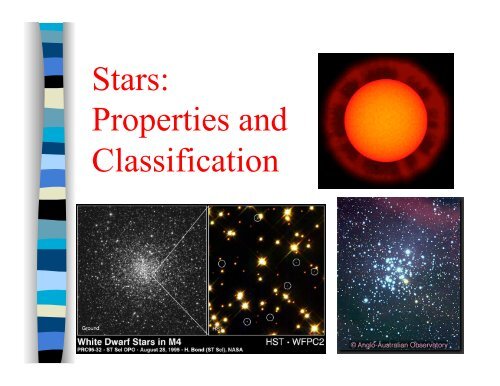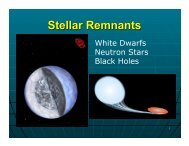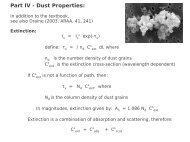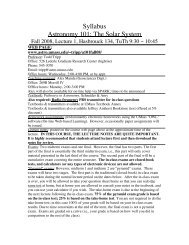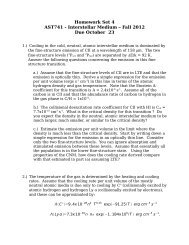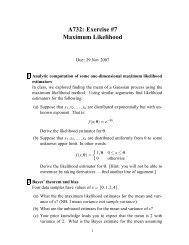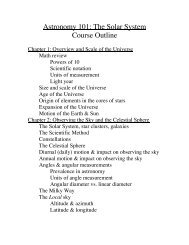Stars: Properties and Classification
Stars: Properties and Classification
Stars: Properties and Classification
Create successful ePaper yourself
Turn your PDF publications into a flip-book with our unique Google optimized e-Paper software.
<strong>Stars</strong>:<br />
<strong>Properties</strong> <strong>and</strong><br />
<strong>Classification</strong>
Announcements<br />
n Homework # 5 starts today. Due Tuesday, Nov 15 th .<br />
n Grades for Quiz # 4 are available in the OWL<br />
Gradebook<br />
n In-class Exam # 2 will take place on Tuesday, Nov<br />
8 th .<br />
– Please check www.astro.umass.edu/~calzetti/astro100 for<br />
more infos
Assigned Reading<br />
n Units 52.1-2-3, 54.1-2-3, 55, 56, 57.1-3
Goals for the Day<br />
n To begin a study of stars – what theyre<br />
made of, what kinds are out there, how<br />
they are born, <strong>and</strong> how they die.<br />
Are all stars similar to our Sun?<br />
How far away are they?<br />
Where did they come from?<br />
What do they do?<br />
Do they live forever?<br />
How do they die?
n There are four principal characteristics<br />
of a star:<br />
– Luminosity<br />
– Surface Temperature<br />
– Size<br />
– Mass<br />
Three of them (luminosity, size, <strong>and</strong> mass) require<br />
knowledge of the distance of the star from us.
Stellar Parallax<br />
The measurements are taken six months apart.<br />
The baseline is the diameter of the Earth’s orbit.<br />
What is seen<br />
What is seen<br />
The ½ of the angle between the current location <strong>and</strong> the<br />
6-month location is called the stellar parallax = P.
1 (AU)<br />
D (in Parsecs) =<br />
P (in arcseconds)<br />
P, the parallax angle, is measured in arcseconds<br />
60 arcseconds = 1 arcminute<br />
60 arcminutes = 1 degree<br />
There are 3600 arcseconds in a degree<br />
The larger P, the smaller D<br />
The smaller P, the larger D<br />
1 parsec = 3.26 light years<br />
= 3.086x10 16 meter<br />
Parallax Distance
Parallax would be easier to measure if<br />
1) the stars were further away.<br />
2) Earth's orbit were larger.<br />
3) Earth moved backwards along its<br />
orbit.<br />
4) none of these.
Parallax would be easier to measure if<br />
1) the stars were further away.<br />
2) Earth's orbit were larger.<br />
3) Earth moved backwards along its<br />
orbit.<br />
4) none of these.
Star A has a parallax angle that is twice that<br />
of Star B. What is the relationship between<br />
their distances?<br />
n Star A is closer than Star B<br />
n Star B is closer than Star A<br />
n The stars are at the same distance<br />
n Not enough information is given
Luminosity<br />
Luminosity is the total amount of power given off by<br />
a star.<br />
- Since its a power, Luminosity is measured in Watts<br />
- For convenience, we often refer to the luminosity of<br />
a star in terms of the luminosity of the Sun.<br />
- Eg,<br />
- That star has a luminosity of 22L Sun <br />
- That galaxy has a luminosity of 2x10 12 L Sun
There is a Big Range of Stellar<br />
Luminosities Out there!<br />
Star<br />
Luminosity (in units<br />
of solar Luminosity)<br />
Sun 1<br />
Proxima Centauri 0.0006<br />
Rigel (Orion) 70,000<br />
Deneb (Cygnus) 170,000
The Sun radiates an enormous amount of energy<br />
(L Sun =4 x 10 26 Watts). Only about 10 -9 of this<br />
actually hits the Earth. Yet, the power of sunlight<br />
that illuminates a patch of desert 100 km x 100 km<br />
is equal to the total power consumption of the US.<br />
4 x 10 26 Watts radiated<br />
over entire surface<br />
~10 17 Watts striking<br />
the Earth<br />
4 x 10 26 Watts generated<br />
in core
Recall the inverse square law….
Brightness is different from Luminosity<br />
n Luminosity – the total amount of power being released<br />
from a star (this is an intrinsic property of the star).<br />
n Brightness – the power from that star that actually gets<br />
to us. This is the quantity we measure with a telescope.<br />
A <strong>Stars</strong> brightness depends on its distance from us.<br />
- there are stars much more luminous than our sun<br />
in the sky, however, they are not nearly as bright because<br />
they are far away.<br />
A stars apparent brightness B = luminosity<br />
4π (distance) 2 =<br />
L<br />
4π d 2
Surface Temperature<br />
n We determine a stars surface<br />
temperature by examining its blackbody<br />
emission (a.k.a. its continuous<br />
spectrum or color)<br />
n No information on distance is<br />
necessary!<br />
n For reference: the Suns surface<br />
(photosphere) temperature is 5,800 K
Surface Temperature
Another (more accurate) method to<br />
measure Temperatures in <strong>Stars</strong><br />
Using spectra (recall the Fraunhofer spectrum of the Sun):<br />
The `dark lines are created when the atoms in the photosphere<br />
have energy levels that match the photons that are emitted<br />
from the star.<br />
1. They `reveal the composition of the star.<br />
2. The strength of the lines (how `dark they are) depend on<br />
the stars surface temperature.
Spectral Types<br />
For historical<br />
reasons, astronomers<br />
classify the<br />
temperatures of stars<br />
on a scale defined by<br />
spectral types, called<br />
O B A F G K M L T,<br />
ranging from the<br />
hottest (type O) to<br />
the coolest (type M)<br />
stars.<br />
The Sun has spectral type G2
Stellar Size<br />
n <strong>Stars</strong> are very spherical so we<br />
characterize a stars size by its radius.<br />
R<br />
Stellar Radii vary in size<br />
from ~1500xR Sun for a<br />
large Red Giant to<br />
0.008xR Sun for a White<br />
Dwarf.
Use Temperature <strong>and</strong> Luminosity<br />
to Measure Size<br />
A stars luminosity, surface temperature, <strong>and</strong> size are all<br />
related by the Stefan-Boltzmann Law:<br />
A refresher: the Stefan-Boltzmann Law<br />
L=4πR 2 σT 4<br />
Luminosity<br />
Stellar<br />
radius<br />
Surface<br />
temperature
L=4πR 2 σT 4<br />
Survey Question<br />
Two stars have the same surface temperature, but<br />
the radius of one is 10 times the radius of the other.<br />
The larger star is<br />
1) 10 times more luminous<br />
2) 100 times more luminous<br />
3) 1000 times more luminous<br />
4) 1/10 th as luminous<br />
5) 1/100 th as luminous
L=4πR 2 σT 4<br />
Survey Question<br />
Suppose two stars are at equal distance <strong>and</strong> have the same<br />
radius, but one has a temperature that is twice as great as the<br />
other. The luminosity of the hotter star is ____ as<br />
the other.<br />
1) 1/2 as great<br />
2) 1/4 as great<br />
3) the same<br />
4) 4 times as great<br />
5) 16 times as great
L=4πR 2 σT 4<br />
Survey Question<br />
Suppose two stars are at equal distance <strong>and</strong> have the same<br />
radius, but one has a temperature that is twice as great as the<br />
other. The apparent brightness of the hotter star is ____ as<br />
the other.<br />
1) 1/2 as great<br />
2) 1/4 as great<br />
3) the same<br />
4) 4 times<br />
5) 16 times as great
Stellar <strong>Properties</strong> Survey Questions<br />
1) Luminosity 2) Radius<br />
3) Surface Temperature<br />
Question #1:<br />
Which property do we determine by first measuring<br />
the stars apparent brightness <strong>and</strong> distance?
Stellar <strong>Properties</strong> Survey Questions<br />
1) Luminosity 2) Radius<br />
3) Surface Temperature<br />
Question #2:<br />
Which property do we determine by measuring<br />
the wavelength of peak emission (i.e., its color)?
Mass: How do you measure the<br />
mass of a star?<br />
n Mass is the single most important<br />
property in determining how a stars life<br />
<strong>and</strong> death will proceed.<br />
n We can weigh stars that are in binary<br />
systems (two stars orbiting each other).<br />
Fortunately, most stars (about 70%) fall<br />
into this category.
Center of Mass (or Barycenter)<br />
n <strong>Stars</strong> orbiting<br />
each other orbit<br />
around their<br />
`center of mass<br />
or barycenter<br />
n They behave<br />
like children on a<br />
seesaw<br />
M a<br />
M b<br />
C.M.<br />
R b<br />
R a<br />
C.M. (center of mass) is where:<br />
R a M a = R b M b
Binary <strong>Stars</strong>: use the Generalized Keplers Third Law<br />
Star A<br />
- Binary stars are in orbit around<br />
each other.<br />
- They orbit around their C.M.<br />
C.M.<br />
R b<br />
R a<br />
- Their orbital period depends on<br />
their separation <strong>and</strong> their masses.<br />
Star B<br />
Generalized Keplers Third Law<br />
(M a +M b ) P 2 = a 3<br />
Keplers Third Law<br />
G/4π 2 M sun P 2 = a 3<br />
a= (R a +R b )/2<br />
Big P = Small Masses<br />
Small P = Big Masses
I. Visual Binaries
Summary<br />
n There are four principal characteristics<br />
of a star:<br />
– Luminosity (brightness <strong>and</strong> distance)<br />
– Surface Temperature (black-body spectrum)<br />
– Size (Stefan-Boltzmann Law)<br />
– Mass (generalized Keplers Third Law)<br />
Are these quantities related with each other?
Lets recall:<br />
Hydrostatic Equilibrium of <strong>Stars</strong><br />
Thermal<br />
Pressure<br />
Gravitational<br />
Contraction
Nuclear fusion rate<br />
rises dramatically<br />
The Stellar Thermostat<br />
Outward thermal pressure of core<br />
is larger than inward gravitational<br />
pressure<br />
Core exp<strong>and</strong>s<br />
Exp<strong>and</strong>ing core cools<br />
Contracting core heats up<br />
Nuclear fusion rate<br />
drops dramatically<br />
Core contracts<br />
Outward thermal pressure<br />
of core drops (<strong>and</strong> becomes<br />
smaller than inward grav. pressure)
What happens if we increase the<br />
mass of the star?<br />
n More mass = more gravitational<br />
contraction<br />
n = need for more balancing pressure =<br />
higher temperature at the center (<strong>and</strong><br />
on the surface)<br />
n Higher temperature = more hydrogen<br />
fusion = higher energy production =<br />
more luminous
Thus…<br />
n More massive =<br />
n Higher Temperature<br />
(bluer color) =<br />
n More luminous<br />
L ~ M 3.5<br />
A star 10 times more massive than the Sun is ~3000<br />
times more luminous!
The Hertzsprung-Russell Diagram
The Hertzsprung-Russell Diagram
The Hertzsprung-Russell Diagram<br />
The Main Sequence<br />
- all main sequence<br />
stars fuse H into He<br />
in their cores<br />
- this is the defining<br />
characteristic of a<br />
main sequence star.<br />
- more massive stars<br />
are more luminous <strong>and</strong><br />
hotter: L=4πR 2 σT 4
The Hertzsprung-Russell Diagram<br />
L=4πR 2 σT 4<br />
Red Giants<br />
- Red Giant stars<br />
are very large, cool<br />
<strong>and</strong> quite bright.<br />
Ex. Betelgeuse is<br />
100,000 times more<br />
luminous than the Sun<br />
but is only 3,500K on<br />
the surface. Its radius<br />
is 1,000 times that of the<br />
Sun.
The Hertzsprung-Russell Diagram
The Hertzsprung-Russell Diagram<br />
White Dwarfs<br />
- White Dwarfs<br />
are hot but since<br />
they are so small,<br />
they are not very<br />
luminous.<br />
L=4πR 2 σT 4
The Hertzsprung-Russell Diagram<br />
Mass of<br />
Star<br />
Size of Star


